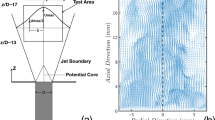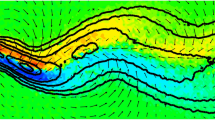Abstract
We present measurements of the fine structure of a passive scalar plume in uniformly sheared turbulence generated in a water tunnel. We report on the mixed velocity-scalar statistics of the plume, including the probability density functions of the velocity, scalar, and scalar derivatives, as well as conditional expectations of the velocity and the scalar derivatives, conditioned upon the scalar fluctuations. Such results are particularly relevant to models that are intended to be used for solving the balance equation of the scalar pdf. Specifically, we address the effect of having a highly intermittent scalar field, in which case the scalar pdf is highly skewed and non-Gaussian and the conditional expectations of the velocity components are distinctly non-linear.
Article submitted to the iTi Conference on Turbulence, Bertinoro, Italy, September 22–24, 2014.
Access provided by Autonomous University of Puebla. Download conference paper PDF
Similar content being viewed by others
Keywords
These keywords were added by machine and not by the authors. This process is experimental and the keywords may be updated as the learning algorithm improves.
Details on the fine structure of turbulent mixing are particularly relevant for the modelling of chemical reactions and combustion. A popular approach for analyzing reactive flows is to consider the balance equation of the scalar probability density function (pdf) [1–3]. Although these equations have certain advantages over conventional Reynolds-averaged balance equations of velocity and scalar moments, they are complicated by the appearance of conditional expectations of the velocity and the scalar dissipation values, conditioned upon the scalar fluctuations. Most previous studies have focused on flows in which the velocity and scalar are nearly homogeneous and jointly-Gaussian, in which case these conditional expectations would be linear functions of the scalar value [2–4]; however, this would not necessarily be the case for inhomogeneous scalar fields as they would appear in industrial and environmental flows and even in many canonical flows, such as turbulent plumes, jets, wakes, and mixing layers.
The objective of the present study is to investigate experimentally the fine structure of a passive scalar plume of a solution of Rhodamine 6G dye (\(Sc = 2500\)) injected isokinetically from a fine tube in uniformly sheared turbulence generated in a water tunnel (Fig. 1). Measurements of the turbulent velocity and concentration fields in cross-sections of the plume were obtained simultaneously with the use of stereoscopic particle image velocimetry (SPIV) and planar laser induced fluorescence (PLIF). The present results complement previous reports of absolute and relative turbulent diffusion of the same plume [5–7], which have also documented the measurement procedure in detail.
The scalar field In the present flow, the turbulence was nearly homogeneous but strongly anisotropic [8]. The present plume was very slender by comparison to the dominant eddies of the turbulence; consequently, the scalar field was highly intermittent. A representative instantaneous concentration map, shown in Fig. 2a, illustrates the sinuous nature of the plume and its extensive meandering. At all points in the cross-section, the scalar intermittency factor \(\gamma _c\), defined as the portion of time during which the concentration was non-zero, was lower than 0.4. Maps of the mean concentration had the shape of a 2D Gaussian function (Fig. 2b, c) and the standard deviation of the concentration fluctuations exceeded the mean concentration.
a Representative instantaneous concentration map at \(x_1/L = 28\), normalized by the injected dye concentration \(C_S\). b Mean concentration map at \(x_1/L = 28\), with the three regions of interest indicated by squares. c Profiles of the mean concentration and the standard deviation of the concentration fluctuations; dashed lines represent Gaussian profiles
Probability density functions In the following, we will present representative measurements at three locations: on the axis of the plume and at two locations on either side of the axis and along the mean velocity gradient direction, near the two inflection points of the mean concentration profile (Points C, F and S, respectively). Unlike the pdfs of the velocity fluctuations (Fig. 3a), which were Gaussian, the pdfs of the scalar fluctuations (Fig. 3b) were highly skewed and were bounded on the low side by the zero concentration and on the high side by a value that was significantly lower than the injected dye concentration \(C_S\); these observations are consistent with previous measurements in thin plumes [9, 10]. At all three locations, the scalar pdfs nearly coincided, although at the off-centre locations (F and S) the pdfs had slightly higher values in the tails, which can be attributed to the peak generation of scalar fluctuations at the inflection points of the mean scalar field. For small concentration fluctuations (\(c/c^\prime < 4\)), the scalar pdf could be described by a gamma distribution, whereas, the tails (\(c/c^\prime > 5\)) were best described by an exponential distribution.
Conditional expectations The conditional expectations of the velocity components conditioned upon the scalar value in the present plume were distinctly non-linear (Fig. 4), unlike those in flows with homogeneous scalar fields in which the joint velocity-scalar pdfs were nearly Gaussian [2–4]. The variation of \(\overline{u_2/u_2^\prime | c/c^\prime }\) illustrates that negative scalar fluctuations (i.e., mostly undyed fluid) are associated with motions that originated outside the plume, whereas positive scalar fluctuations are associated with motions that originated largely in the core of the plume. Furthermore, the curves have steep vertical asymptotes on the negative side which are attributed to the fact that the scalar fluctuations are bounded on the negative side by the zero concentration. The variation of \(\overline{u_1/u_1^\prime | c/c^\prime }\) had the opposite trends, which is consistent with the sign and strong magnitude of the Reynolds stress \(\overline{-u_1u_2}\) in this shear flow [8]. As expected by considering the symmetry of the turbulence and the mean plume, \(\overline{u_3/u_3^\prime | c/c^\prime }\) was zero at \(x_3 = 0\).
Scalar derivatives Measurements of the scalar derivatives are particularly relevant as surrogates for the scalar dissipation rate [3]. The pdfs of the transverse scalar derivative (Fig. 5) were highly peaked with long nearly-exponential tails, comparable to those measured in flows with less inhomogeneous scalar fields [3, 4, 11]. This is attributed to the small-scale intermittency of the scalar even in flows with Gaussian scalar pdfs. The conditional expectations of the transverse scalar derivative at all measurement locations (Fig. 5b) were also distinctly non-linear functions of the scalar value, although their signs were consistent with the signs of the corresponding local mean scalar derivatives [12].
In summary, these results demonstrate that in a highly intermittent scalar field, the scalar pdf is strongly non-Gaussian and the conditional expectations of the velocity components and the scalar dissipation, conditioned upon the scalar value, are distinctly non-linear.
References
Pope, S.: Turbulent Flows, Cambridge University Press, Cambridge (2000)
Mydlarski, L.: J. Fluid Mech. 475, 173–203 (2003)
Behnamian, A., Tavoularis, S.: In Eighth International Symposium on Turbulence and Shear Flow Phenomena (TSFP8). Poitiers, France (2013)
Ferchichi, M., Tavoularis, S.: J. Fluid Mech. 461, 155 (2002)
Vanderwel, C., Tavoularis, S.: Phys. Rev. E 89(4), 041005 (2014)
Vanderwel, C., Tavoularis, S.: J. Fluid Mech. 754, 488 (2014)
Vanderwel, C., Tavoularis, S.: Exp. Fluids 55, 1801 (2014)
Vanderwel, C., Tavoularis, S.: J. Fluid Mech. 689, 434 (2011)
Rahman, S., Webster, D.: Exp. Fluids 38(3), 372 (2005)
Lavertu, R., Mydlarski, L.: J. Fluid Mech. 528, 135 (2005)
Jayesh, Z.: Warhaft. Phys. Fluids A 4(10), 2292 (1992)
Tavoularis, S., Corrsin, S.: J. Fluid Mech. 104, 349 (1981)
Acknowledgments
Financial support by the Natural Sciences and Engineering Research Council of Canada (NSERC) is gratefully acknowledged.
Author information
Authors and Affiliations
Corresponding author
Editor information
Editors and Affiliations
Rights and permissions
Copyright information
© 2016 Springer International Publishing Switzerland
About this paper
Cite this paper
Vanderwel, C., Tavoularis, S. (2016). The Fine Structure of a Slender Scalar Plume in Sheared Turbulence. In: Peinke, J., Kampers, G., Oberlack, M., Wacławczyk, M., Talamelli, A. (eds) Progress in Turbulence VI. Springer Proceedings in Physics, vol 165. Springer, Cham. https://doi.org/10.1007/978-3-319-29130-7_45
Download citation
DOI: https://doi.org/10.1007/978-3-319-29130-7_45
Published:
Publisher Name: Springer, Cham
Print ISBN: 978-3-319-29129-1
Online ISBN: 978-3-319-29130-7
eBook Packages: Physics and AstronomyPhysics and Astronomy (R0)









